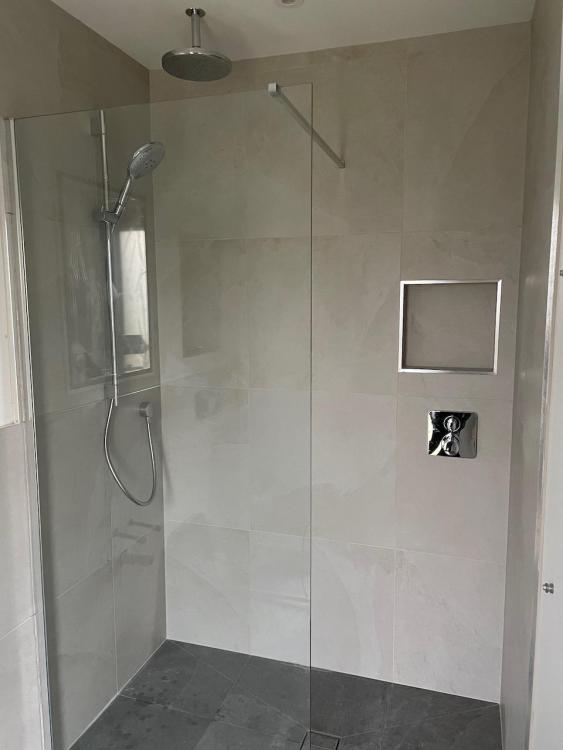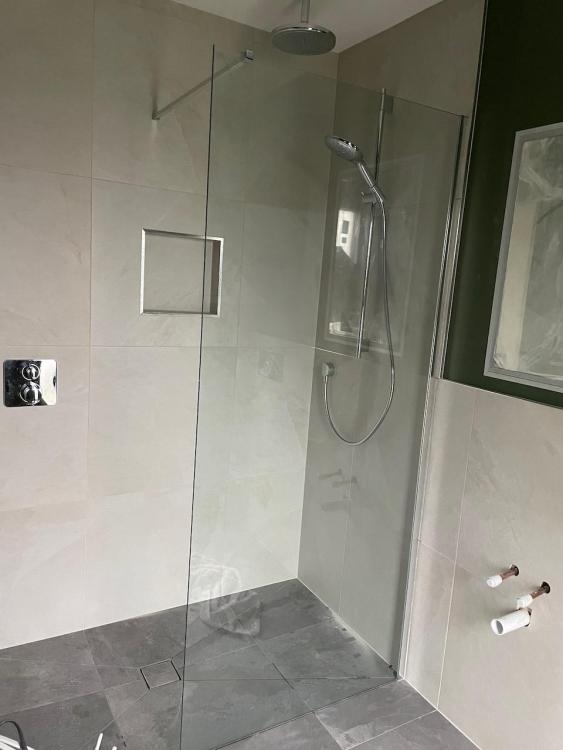Leaderboard
Popular Content
Showing content with the highest reputation on 01/14/24 in all areas
-
2 points
-
Well done you for giving this a go.. If you want I can give you a few pointers on what you need to do to get the preliminary sizes for you timber frame (TF) and the grades of timber you may need. To do that I would need to know.. A: The floor plan dimensions, location of the internal load bearing walls roof pitch and need to know about any funny loads you are introducing.. pool tables ect.. B: The ground, first and second floor levels. C :The sizes of the openings.. windows and doors. D : Your post code so I can assess the wind and snow loading. I'm minded to give this a go with my SE hat on as.. 1/ You have made a good effort. 2/ It may help other folk on BH understand what goes into the preliminary sizing of a timber frame.2 points
-
Wtf is a trap door? And why would you need 70 of them? Sounds dodgy to me. Might be worth questioning it with the builder to see what they say they’re for.1 point
-
1 point
-
The only way to be sure it won't stop working when the OEM turns off their server is to buy stuff that connects to a server you host yourself. So it's a a trade off between faff and longevity. The sweet spot would be IoT that easily lets you decide who's server to use (so you can change it over when the OG server fails) but the options for this are few and far between. The vast majority of chinesium WiFi devices use the Tuya platform and their servers. This is actually a fairly decent platform, and so far I've not seen stuff failing. But most the Tuya stuff I own I've flashed with custom firmware to connect to my own (Home Assistant) server. Perhaps the sweet spot is Shelly devices. These come with a cloud service they hose, but also a local API and good local integration with Home Assistant. So out of the box you have remote access and schedules/automations, but you can also do a lot more with them offline if requirements evolve.1 point
-
Removing internal walls in a listed building needs permission too.1 point
-
1 point
-
I've a couple meross WiFi thermometers / hygrometers and smart plugs that monitor energy consumption. The plugs are full 13amp and can be set on schedules or remotely turned on or off. No hub or subscriptions needed. All work really well.1 point
-
Why would you want a single layer of wood in place of a DG unit? cold, damp and unsightly in my opinion, and I definitely wouldn’t be paying £6k for the privilege1 point
-
Project this year is to improve a small porch off the back door. Remove pitched roof and make lean-to roof with 2nd hand Velux I've acquired. Move a door from end to side. Remove two old windows and replace one with a DG one I've bought cheep. Take up hard floor and insulate to stop floor condensation. Try and insulate as much of the cavity as possible. At nearly 80 I do wonder sometimes! Will need some help!1 point
-
think that'll be a while yet. the UFH and towel rails aren't working yet and so the floor is pretty darn cold. wouldn't really be the luxurious shower we are hoping for!1 point
-
Thread moved to the roofing section. Your issue is most likely the fixing bolts are in the trough of the corrugations where lots of water runs down. They are usually in the peaks, where there won't be flowing water so less likely to leak. Take each bolt out one at a time, apply lots of waterproof sealant and re fit.1 point
-
we have a basement and I was told by the architect that we needed an external escape route to comply with building regulations so we designed one in, and also escape windows/doors at the first floor level. at no point was I told that we could have a misting system to mitigate this need and I was very new to building and didn't know much at that point. if I knew then what I know now I would seriously look in to a misting system (which is I believe standard in Scotland) to mitigate the fire escape requirements.1 point
-
Turns out they have: Yates T. (2002). Final report on the construction of the hemp houses at Haverhill, Suffolk, client report 209-717 Rev2, BRE, Watford, 2002. I don't have a copy, but the CAT mention key findings in a report: https://www.votehemp.com/wp-content/uploads/2018/09/building_with_hemp_and_lime.pdf Short version - two houses were built, sponsored by the Suffolk Housing Society in collaboration with BRE, who performed a full assessment. Despite having higher U-values (Hemp homes 0.58 w/m2.K Control Homes 0.35 w/m2/k) they performed as well as the standard construction, occupied or unoccupied. This may be partly explained by hempcrete's 'thermal mass', low thermal bridging & airtightness.1 point
-
My pragmatic view. Your starting point is to spend a bit of money investigating the ground up front and in particular the behaviour of the ground water if considering a basement This is where the cost uncertainty lies and the big risk. If you don't do this now you'll spend countless wasted hours trying to figure out the superstructure design.. and then you may have to revisit all of that once you learn later about the ground. Now that and the following may seem a bit of a lecture but if you go to a TF company / basement company for example with limited information they will suss that out and inflate the price to cover the added risk / uncertainty. There are basically two rates.. if you have a Client that has not got a clue.. there is a risk there.. so you add more to the price. A well informed Client with good drawings and a bit of professional backup.. you charge less as the risk is reduced.. in the round you end up making the same profit as a Contractor. How? well... if there are extras the professional team often play fair with you so you get a fair days work for a fair days pay. Mind you if you a Contractor who does not recognise fair play.. then the gloves come off. To give you a ball park figure. You could get this kind of preliminary advice for about £1500.00. But once you get chatting to the person who is giving the advice they will tell you loads of other stuff, point out the pitfalls and engage with you... after a couple of conversations you'll probably realise that you have got value for money. For me all I need to do to wash my face is to save you one weeks labour on site for two operatives. The sum is a bit like this this.. 1 x a skilled operative at 8 hours per day @ £250.00 per day for a week = 5 x 250 = £1250 A labourer at £120 per day x 5 = £600.00 £1250 + 600 = £1850.00 > my £1500.00 Now that is my rough sum.. but I know I can easily save folk that. It's just that folk don't believe it until they find out later that they maybe went about it the wrong way. I know some BH folk are a hostile towards Architect's but @ETC is one and very experienced... just speculate.. how much someone like that could save you but still achieve the same in terms of Architectural design if you get them into the fold for the whole project! Now imagine if you got both the SE, Architect and you all on the team early on.. The savings can be massive.. In some ways the professionals self regulate for the benefit of the project if they are committed. There are some folk on BH that don't need this level of support, some are essentially highly experienced developers with a professional construction background. But most folk on BH are not like that.. I'm trying to look at it in the round. I did a self build many years ago and certainly did not know what I know now.. also at that time there was no internet and no Buildhub where you could go for advice.. I made mistakes / lost money based on what I know now. In summary get an impartial professional in early who can guide and give you the information you need to make an informed decision, you still have control over the process.1 point
-
Have you visited the Centre for Alternative Technology and the Wise building? Wall mainly insulated with Hempcrete - https://cat.org.uk/info-resources/free-information-service/building/the-wise-building/ If I had the opportunity again I'd seriously consider it for a build myself. I think that might have been me. From the standpoint of that research, then if you want both vapour permeability and moisture buffering, then gypsum would be preferable to Lime, yes, and gypsum plaster would be preferable to plasterboard on the basis of the more dynamic tests conducted as part of the thesis. With that being said, we also have to keep in mind that as per the discussion part of the paper, the behaviour of these materials and the building aren't static. For example the moisture buffering behaviour of gypsum (with micro-pore structure) increased in variable temperature scenarios but sinusoidal RH variations reduced the moisture buffering behaviour of all materials. The whole research provides some very interesting data, but also throws up alot of questions, particularly about the overall behavour in real world scenarios of indoor and outdoor environments. To me what is interesting is that the concrete wall performed almost as well as the woodfibre in buffering moisture.1 point
-
Read the attached first.. once you get a handle on the basics you may find the solution is staring you in the face. If this guide is not enough then you'll be much more informed when you call the lead association, they will appreciate that and will tend to recognise that you have made an effort yourself to solve the problem on your own... but just got stuck. Calder guide to leadwork -GTGLW-210213(5).pdf1 point
-
I hate to say it, but seems more like hopium than a solution. Is there any proper research as to the long term performance. Yes. The French Réhafutur 1 research project (http://www.rehafutur.fr/) was the initial research project, a collaboration between the housing association Maisons et Cités and the University of Artois, with support from the regional Eco-business Creation and Development Association (CD2E), the French Building Federation, the Federation of Construction Employers Cooperatives, and others. It's 60 miles inland from Calais, south of Lille, so a similar climate to southern UK. The 4 elevations were insulated with different materials: 300mm hempcrete blocks in thin-bed lime mortar, with the gap against the brick wall filled with hemp fibre (so functionally similar to the in-situ hempcrete linked to above) 350mm blown-in cellulose fibre 350mm flax wool 360mm sheep wool There's some brief info here in English - https://www.isohemp.com/en/hemp-solution-heritage-renovation and a video of the insulation here in French: https://www.youtube.com/watch?v=QkR4WATzp0Q The building was monitored by the regional Civil Engineering & géo-Environnement Laboratory (LGCgE) using 80 probes, measuring temperature & heat flow (on the internal surfaces, external surfaces, and boundary between insulation and structure of the external envelope), temperature & hygrometery (in the centre of the insulation), ventilation air flow & internal air quality. Energy use was logged and the external weather measured. Various metrics were calculated including actual -v- predicted U-values, thermal inertia and thermal decoupling; plus acoustic performance, materials wastage, embodied energy, cost effectiveness, environmental life cycle analysis, etc. The outcome of this (and a subsequent pilot) was that the hempcrete was judged the optimal solution for wall insulation. As a result an initial 50 houses were insulated with hempcrete in Pecquencourt a couple of years ago (to be increased to 115), with a plan to expand that to 1,000 by around 2026, and eventually more as the local production capacity and knowledge are developed. There's some info on these plans in English here: https://batinfo.com/en/actuality/le-bailleur-maisonscites-lance-lexperimentation-pecquenchanvre_19931 and a video in French here: https://www.youtube.com/watch?v=7u8gxdJP_pU1 point
-
Thank you. My gut says it won’t be an issue as it does seem unreasonable but I just wondered what people thought on here and if there was any sort of measurement for gardens (like there is the 25 degree rule for actual houses). fingers crossed…..1 point
-
In a traditional building that is subject to some moisture, one option I'd consider is adding hempcrete to the inner face of the wall, improving the U-value and maintaining breathability without isolating the interior from the 'thermal mass' of the wall. There's an example here: https://lowcarbonbuildings.wordpress.com/2019/09/15/a-domestic-insulation-project-chapter-3-weeks-of-weetabix-walls/1 point
-
Sorry I was a bit off with my calcs. 10mm of a thermal conductivity of 0.0195W/mK will give a U value of 1.95W/m2K. for £150. 18mm of Rockwool with a thermal conductivity of 0.035W/mK will also give you a U value of 1.95W/m2K. You can't buy 18mm though so if you can fit 25mm of rockwool it'll be a U Value of 1.4W/m2K for a cost of £3.1 point
-
Sounds similar to what I’m doing at the moment! Look forward to seeing progress! Good luck!1 point
-
1. we simply used a damp proof membrane and connected it to the skirting, which tucks nicely under the DPC (on the internal skin). essentially, you have a barrier between ground level and floor, absolutely no issue with humidity at all, with the extension sitting nicely at 50%, except for in the summer, when the doors are open a lot and the humidity inside reflects what's outside. 2. internal wall between existing kitchen and extension was taken down to screed level, so we didn't remove any bricks from the "footings". we then used liquid DPM to close any tiny gaps, but that was completely unnecessary, as the underside of the extension is bone dry anyway. we then used self-levelling compound to combine everything nicely, again, all nice and dry despite a lot of rain and humidity. 3. we removed the internal skin along the width of the bifold and used the same damp proof membrane to create a "tray" underneath the screed and insulation. again, absolutely no problems with humidity, but I have to admit that area of the floor is a bit colder that the rest, despite using celotex. not a big deal and there's no condensation, which for me is good enough. from the outside, you can see the ground level at 3 bricks under the internal floor, with a DPC 2 bricks above ground floor, so it's quite difficult for anything to get damp/wet, even in heavy rain.1 point
-
I've heard about it, but never seen it.... Until today. Some context. This 15mm pipe (0.7mm wall) was just downstream of a flow restrictor valve (so pretty turbulent) which has run continuously at 8-10lpm for about 10 years. The water is very soft but more or less pH neutral. I noticed it was weeping at the push fitting onto the restrictor body and removed it to refit. The pipe was paper thin, I actually crushed it with my fingers. There were numerous pin holes out to about 25mm from the pole end and the inside was very pitted, almost rusty in appearance.0 points
This leaderboard is set to London/GMT+01:00











